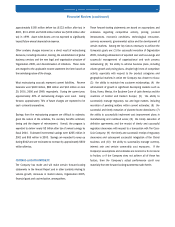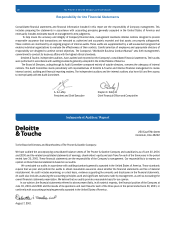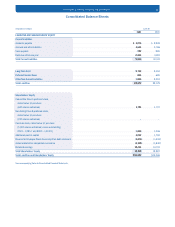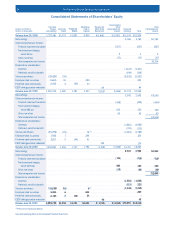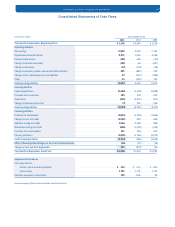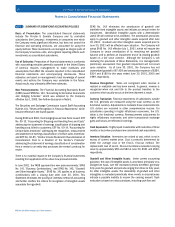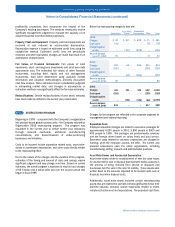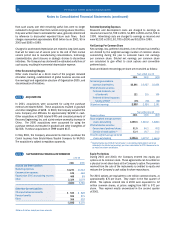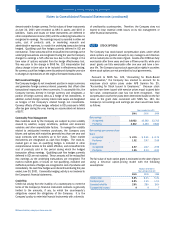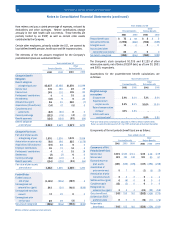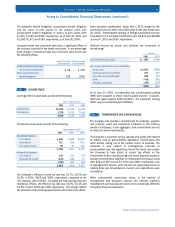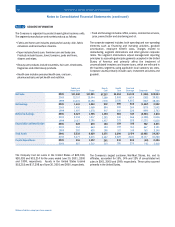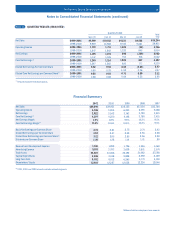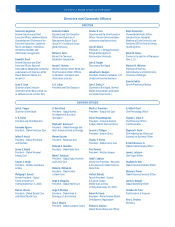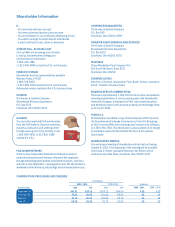Proctor and Gamble 2001 Annual Report Download - page 31
Download and view the complete annual report
Please find page 31 of the 2001 Proctor and Gamble annual report below. You can navigate through the pages in the report by either clicking on the pages listed below, or by using the keyword search tool below to find specific information within the annual report.
29
Millions of dollars except per share amounts
offsets. For the residual portion, the Company enters into various
derivative transactions pursuant to the Company’s policies in areas
such as counterparty exposure and hedging practices. Designation
is performed on a specific exposure basis to support hedge
accounting. The changes in fair value of these hedging instruments
are offset in part or in whole by corresponding changes in the fair
value or cash flows of the underlying exposures being hedged. The
Company does not hold or issue derivative financial instruments for
trading purposes.
Interest Rate Hedging
The Company’s policy is to manage interest cost using a mix of fixed-
and variable-rate debt. To manage this mix in a cost efficient
manner, the Company enters into interest rate swaps in which the
Company agrees to exchange, at specified intervals, the difference
between fixed and variable interest amounts calculated by reference
to an agreed-upon notional principal amount.
At June 30, 2001, the Company had swaps with a fair value of $125
designated as fair value hedges of underlying fixed-rate debt
obligations and recorded as long-term assets. The mark-to-market
values of both the fair value hedging instruments and the underlying
debt obligations are recorded as equal and offsetting gains and
losses in the interest expense component of the income statement.
All existing fair value hedges are 100% effective. As a result, there is
no impact to earnings due to hedge ineffectiveness.
Non-qualifying instruments are also recorded on the balance sheet at
fair value, but the impact was not material to the income statement.
Currency Rate Hedging
The Company manufactures and sells its products in a number of
countries throughout the world and, as a result, is exposed to
movements in foreign currency exchange rates. The Company’s
major foreign currency exposures involve the markets in Western and
Eastern Europe, Asia, Mexico and Canada. The primary purpose of
the Company’s foreign currency hedging activities is to manage the
volatility associated with foreign currency purchases of materials and
other assets and liabilities created in the normal course of business.
The Company primarily utilizes forward exchange contracts and
purchased options with maturities of less than 18 months and
currency swaps with maturities up to five years.
The Company enters into certain foreign currency derivative
instruments that do not meet hedge accounting criteria. These
primarily are intended to protect against exposure related to
intercompany financing transactions and income from international
operations. The fair values of these instruments at June 30, 2001
were recorded as $136 in assets and $16 in liabilities. The net
impact on marketing, research and administrative expense was a
$24 after-tax gain.
In addition, the Company utilizes purchased foreign currency
options, forward exchange contracts and cross currency swaps which
qualify as cash flow hedges. These are intended to offset the effect
of exchange rate fluctuations on forecasted sales, inventory
purchases, intercompany royalties and intercompany loans
NOTE 5 SHORT-TERM AND LONG-TERM DEBT
The weighted average short-term interest rates were 5.3% and 4.8%
as of June 30, 2001 and 2000, respectively.
Long-term weighted average interest rates were 5.0% and 6.1% as
of June 30, 2001 and 2000, respectively, and include the effects of
related interest rate swaps discussed in Note 6.
The fair value of the long-term debt was $10,164 and $9,024 at
June 30, 2001 and 2000, respectively. Long-term debt maturities
during the next five years are as follows: 2002--$622; 2003--
$1,117; 2004--$1,040; 2005--$1,912 and 2006 -- $32.
NOTE 6 RISK MANAGEMENT ACTIVITIES
Effective July 1, 2000, the Company adopted SFAS No. 133,
“Accounting for Derivative Instruments and Hedging Activities,” as
amended, which requires that all derivative instruments be reported
on the balance sheet at fair value and establishes criteria for
designation and effectiveness of hedging relationships. The
cumulative effect of adopting SFAS No. 133 as of July 1, 2000 was
not material.
The Company is exposed to market risks, such as changes in interest
rates, currency exchange rates and commodity pricing. To manage
the volatility relating to these exposures, the Company nets the
exposures on a consolidated basis to take advantage of natural
Notes to Consolidated Financial Statements (continued)
The Procter & Gamble Company and Subsidiaries
June 30
2001 2000
Long-Term Debt
5.25% USD note due 2003
6.00% USD note due 2003
6.60% USD note due 2004
8.33% ESOP debentures due 2003, 2004
1.50% JPY note due 2005
5.75% EUR note due 2005
6.13% USD note due 2008
6.88% USD note due 2009
2.00% JPY note due 2010
9.36% ESOP debentures due 2007-2021
6.45% USD note due 2026
6.25% GBP note due 2030
All other long-term debt
Current portion of long-term debt
$ 750
500
1,000
392
518
–
500
1,000
471
1,000
300
757
2,107
283
9,012
$ 750
500
1,000
306
441
1,270
500
1,000
401
1,000
300
705
2,033
414
9,792
$ 2,188
–
283
770
3,241
$ 675
559
414
585
2,233
June 30
2001 2000
Short-Term Debt
USD commercial paper
Non USD commercial paper
Current portion of long-term debt
Other
( )
( )


